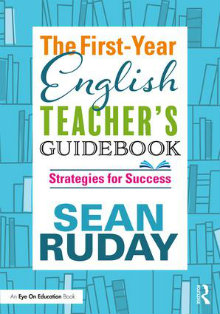Essential Reading for New English Teachers
The First Year English Teacher’s Guidebook: Strategies for Success
By Sean Ruday
(Routledge/Eye On Education, 2018 – Learn more)
 Reviewed by Tara Sherman
Reviewed by Tara Sherman
The First-Year English Teacher’s Guidebook: Strategies for Success keeps its promises. It’s a true guidebook. At every point in the text, author Sean Ruday guarantees that the reader can orient him- or herself within the text to get as much use out of it as possible. And I have been.
 I’m close to an ideal audience for The First-Year English Teacher’s Guidebook. I’m a preservice English teacher, working with eighth graders across a spectrum of abilities. I’m supported. I’m learning a ton from my mentor teacher. I’m learning a ton from my credential program. I’m learning a ton from the educational books, podcasts, and articles I’ve been diving into. It’s a lot.
I’m close to an ideal audience for The First-Year English Teacher’s Guidebook. I’m a preservice English teacher, working with eighth graders across a spectrum of abilities. I’m supported. I’m learning a ton from my mentor teacher. I’m learning a ton from my credential program. I’m learning a ton from the educational books, podcasts, and articles I’ve been diving into. It’s a lot.
Reader, can I be honest? It’s a lot, and the wealth of good stuff gets overwhelming at times. It’s really hard to plan next week’s lessons when you’re paralyzed by so much choice and don’t have the experience to know for sure what the best decision will be.
So The First-Year English Teacher’s Guidebook really works for me, providing insight without putting me into the pickle of profusion.
It’s focused, clocking in at a slim, mean 132 pages. Those 132 pages are rich with ideas and resources, but Ruday emphasizes about a dozen main points. Strategies are categorized by topic area, and each strategy chapter has the same consistent structure. They’re so clearly presented and easy to visualize that no matter how much prior knowledge or experience you have teaching English, as a reader, it’s easy for you to access the information.
Instructional, Assessment, and Work-Life Balance Strategies
Overall, The First-Year English Teacher’s Guidebook is a text that’s written to be used. The whole book is organized for ease and impact. There are three major sections, and the Table of Contents reads like a worthy set of instructional goals. Chapter titles under the categories Instructional, Assessment, and Work-Life Balance Strategies include specific chapters with imperative titles like Incorporate Students’ Out-of-School Lives, Utilize Exit Questions, and Communicate Actively and Carefully with Students and Families, just to name a few of my favorites.
Within each major Strategies section, Ruday methodically breaks down three to four specific practices. Each practice has its own chapter and shared format:
- a brief summary of the chapter to come,
- an explanation of the strategy at hand (“What Is It?”),
- justification for its use and significance (“Why Does It Matter?”),
- a model of the technique via written narrative of Ruday’s experience in the classroom (“What Does It Look Like in Action?”),
- “Key Tips” for implementing the strategy, and a bullet point summary on the strategy, how to use it, and why it’s useful/important (“Final Points on XYZ”).
If you already know why something matters, you can skim Why Does It Matter. If you just want the quickie version of a strategy, you can skip to Final Points. I’m telling you: it’s great.
My Nit-picks
There are a couple areas where I wish Ruday had gone deeper. They’re specific nit-picks, but for a book that otherwise answers the questions it raises in a satisfying, productive manner, they stand out. For one thing, I’m curious about how district-mandated technology-based curriculum can mesh with Ruday’s advice on the purposeful integration of technology.
I have to admit it: his rubrics drive me crazy. His strategy for developing, sharing, and using rubrics is wonderful. But on the rubrics themselves, he eschews a grid with clearly-outlined expectations for each score in favor of a question per category, and a rating of 1-4 in the category for the student.
My own rubric practice is already far enough away from that; I’m working on making rubrics that are less of a hot mess and I’m not interested in doing the additional research myself, but it drives me just a little bonkers that Ruday doesn’t take the time to explain his break from convention. He might have the best of reasons. Or it might simply have been a formatting shortcut that’s book-only.
Helpful Self-Care Suggestions
You know what, though? The final section – on Work-Life Balance Strategies – just might contain solutions. For a book that’s mostly about pedagogy, the self-care section is an inspired inclusion. Just like a picky dog snaps down medicine tucked into steak, a harried, deeply busy, a learning-obsessed first-year teacher will read straight through this section after developing respect for the work in the previous sections.
As much as I’m not interested in being told to meditate, Ruday shares great advice on scheduling, mentoring relationships, and more. In fact, his writing about support networks led me to make myself a “teacher tweeter” – maybe I’ll ask him about the rubrics right now!
A Trustworthy Resource
All in all, The First-Year English Teacher’s Guidebook is a great resource. It’s well-balanced, effective, and research-based. It’s trustworthy and easy to navigate. Many early career teachers could benefit from using it; more experienced instructors interested in updating some of their practices might as well. I wholly recommend it.
Tara Sherman (@mizsherman) is a preservice 8th grade English teacher and avid learner, with a background in sociological research and ongoing focus on equity and innovation. She works in the Sacramento area and can be spotted all over local libraries and coffee haunts.

































